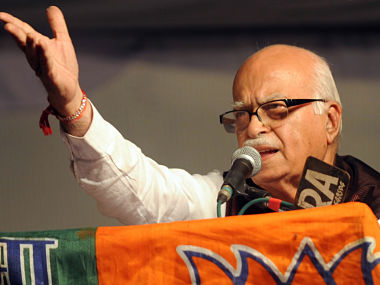Babri Masjid demolition is an indictment of Indian polity; criminal conspiracy charge serves no purpose
03:16PM Tue 7 Mar, 2017

FP| Mar, 07 2017
In criminal jurisprudence mens rea connotes an intention of crime which is no less culpable than the crime itself. When LK Advani, as BJP president, took out the Rath Yatra in 1990, his explicit intention was to build the Ram Temple at the site of Ayodhya where Babri Masjid stood.
The obvious implication was that the mosque had to be replaced with a temple befitting the status of Lord Ram’s birth place. The unambiguous message then was that the mosque would not remain at its original place. But should we blame only Advani for taking out a Rath Yatra that eventually culminated in destruction of the Babri Masjid?
Just three years before the demolition of the Babri Masjid, the then prime minister Rajiv Gandhi laid a foundation at that very site for the construction of the grand Ram Temple amid chanting of Vedic mantras. All this happened when ND Tiwari was the chief minister and Rajiv Gandhi was at the helm.
Similarly, the manner in which the locks were opened inside the dome which housed the idols of Lord Ram and Sita by a court order at Ayodhya in 1986 paved the way for the agitation.
When the Supreme Court pointed out that the criminal conspiracy charge against LK Advani and Murli Manohar Joshi should not have been dropped, it seemed to have ignored the colossal failure of Indian polity to respond to a situation which snowballed into a criminal crisis.
In fact, it would be absolutely wrong to see the demolition of the Babri Masjid on 6 December, 1992 from the angle of individual collaborators of the crime. Thus, the slapping a case of criminal conspiracy charge against Advani, Joshi or Kalyan Singh is unlikely to serve any purpose.
In the past 25 years of investigation, neither the CBI nor the Liberhans Commission could collect credible evidence to arraign the RSS-BJP-VHP leaders and prove the charges of criminal conspiracy. Those investigating the case admit that it is next to impossible to gather evidence against a mob of over one lakh people and press charges of criminality for the destruction of the mosque.
On the contrary, the recording of utterances of leaders like Advani points to a contrary scenario. Advani was seen as pleading with karsevaks (volunteers) to restrain from demolishing the structure. Those that accompanied him on that day later confirmed that quite distraught by events that unfolded.
Advani went to Lucknow’s guest house where he broke down in tears. “That (6 December) was the saddest day of my life” he has maintained in successive interviews.
Of course no one is arguing that the expression of remorse for a crime absolves an accused of culpability. But in the past 25 years, neither the CBI nor the judicial inquiry commission were able to gather evidence that pins down any of the leaders who were at the spot.
And it is highly unlikely that the SC’s attempt to revival of charges of criminal conspiracy would serve any great purpose. Anybody familiar with forensic science would state that it would be impossible to unearth fresh evidence of conspiracy against anyone for a crime committed 25 years ago.
Perhaps the best way to deal with the destruction of Babri Masjid would be to close the investigation and remember it as a monumental failure of Indian polity. The memory of the events leading to 6 December, 1992 should be preserved so that they serve as a grim reminder to the judiciary, executive and political class about their collective failure to respond to a crisis adequately and effectively.
If one looks at history, the destruction of the Babri Masjid could have been prevented if the idols were not kept surreptitiously inside the mosque in 1949 and locks were not, rather deceitfully opened in 1986.
Similarly, Advani and the Sangh Parivar could have been stopped in their tracks even in 1990 by evolving a political consensus against raking up an issue like Ayodhya. But that was not to be.
As of now, instead of reviving a conspiracy case, the Supreme Court should use it as a framework to set up guidelines on how the powers-that-be could respond to such a situation in the future.











